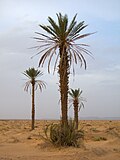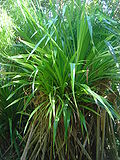|
|
| Line 1: |
Line 1: |
| − | '''Coir''' (from [[Malayalam]] ''kayar'', cord) is a coarse fibre extracted from the fibrous outer shell of a [[coconut]].
| + | {{honor_header|Unknown|Unknown|Household Arts|South Pacific Division/Island Ed.}} |
| | | | |
| − | == Structure == | + | ==1. In your culture name the materials which are used in mat making. == |
| − | Coir fibers are found between the husk and the outer shell of a coconut. The individual fiber cells are narrow and hollow, with thick walls made of [[cellulose]]. They are pale when immature but later become hardened and yellowed as a layer of [[lignin]] is deposited on their walls. There are two varieties of coir. Brown coir is harvested from fully ripened coconuts. It is thick, strong and has high abrasion resistance. It is typically used in mats, brushes and sacking. Mature brown coir fibers contain more lignin and less cellulose than fibers such as [[flax]] and [[cotton]] and so are stronger but less flexible. They are made up of small threads, each about 1 mm long and 10 to 20 [[micrometre]]s in diameter. White coir fibers are harvested from the coconuts before they are ripe. These fibers are white or light brown in color and are smoother and finer, but also weaker. They are generally spun to make yarn that is used in mats or rope.
| + | <gallery> |
| | + | Image:Coco.jpg|Coconut |
| | + | Image:Typha latifolia 02 bgiu.jpg|Bullrush |
| | + | Image:Hemp stem fibre.jpg|Hemp |
| | + | Image:Rice straw.jpg|Straw |
| | + | Image:Phoenix dactylifera2.jpg|Date palm |
| | + | Image:Pandanus dsc03667.jpg|Screw pine |
| | + | </gallery> |
| | + | Mats are made of many, many different types of material, including: |
| | + | * Coir (coconut fibers) |
| | + | * Reeds |
| | + | * Bullrushes |
| | + | * Hemp |
| | + | * Rattan (cane) |
| | + | * Various grasses |
| | + | * Straw |
| | + | * Palm leaves |
| | + | * Screw pine (Pandanus) leaves |
| | | | |
| − | The coir fiber is relatively water-proof and is one of the few natural fibers resistant to damage by salt water. Fresh water is used to process brown coir, while sea water and fresh water are both used in the production of white coir. <ref name="madehow">"[http://www.madehow.com/Volume-6/Coir.html Coir]" from ''[http://www.madehow.com/ How Products Are Made]''</ref>
| + | ==2. Explain and demonstrate how to prepare this material. == |
| | + | ===Coir=== |
| | + | ===Reeds, Bullrushes, and Grass=== |
| | + | ===Hemp=== |
| | + | ===Rattan=== |
| | + | Generally, raw rattan is processed into several products to be used as materials in furniture making. The various species of rattan ranges from several millimetres up to 5-7 cm in diameter. From a strand of rattan, the skin is usually peeled off, to be used as rattan weaving material. |
| | | | |
| − | == Processing == | + | ===Straw=== |
| − | [[Image:Coir_segregation.jpg|right|thumb|Segregation of Coir fibre (Allepey, India)]]
| + | ===Palm leaves=== |
| − | Coconuts are the seed of the palm trees, these palms flower on a monthly basis and the fruit takes 1 year to ripen. A typical palm tree has fruit in every stage of maturity. A mature tree can produce 50-100 coconuts per year. Coconuts can be harvested from the ground once they have ripened and fallen or they can be harvested while still on the tree. A human climber can harvest approximately 25 trees in a day, while a knife attached to a pole can up the number to 250 trees harvested in a day. Monkeys can also be trained to harvest the coconuts, but this practice is less efficient than other methods. Green coconuts, harvested after about six to twelve months on the plant, contain pliable white fibres. Brown fibre is obtained by harvesting fully mature coconuts when the nutritious layer surrounding the seed is ready to be processed into [[copra]] and desiccated coconut. The fibrous layer of the fruit is then separated from the hard shell (manually) by driving the fruit down onto a spike to split it (''De-husking''). A well seasoned husker can manually separate 2,000 coconuts per day. Machines are now available which crush the whole fruit to give the loose fibres. These machines can do up to 2,000 coconuts per hour.
| + | ===Screw pine=== |
| | + | ==3. Name plants that can be used for making dyes in your culture. Tell where they come from and how to prepare them for dying. == |
| | + | ===Rattan=== |
| | + | The fruit of some rattans exudes a red resin called dragon's blood. This resin was used as a dye for violins, among other things. The resin normally results in a wood with a light peach hue. |
| | + | ==4. Show how to use native and synthetic dyes in dyeing mat making material. == |
| | + | ==5. Make two mats showing two different types of weaving. One of the mats must have a reasonably fine weave. == |
| | + | ==References== |
| | | | |
| − | ===Brown fibre===
| + | [[Category:Adventist Youth Honors Answer Book|{{SUBPAGENAME}}]] |
| − | The fibrous husks are soaked in pits or in nets in a slow moving body of water to swell and soften the fibres. The long bristle fibres are separated from the shorter mattress fibres underneath the skin of the nut, a process known as ''wet-milling''. The mattress fibres are sifted to remove dirt and other rubbish, dried in the sun and packed into bales. Some mattress fibre is allowed to retain more moisture so that it retains its elasticity for 'twisted' fibre production. The coir fibre is elastic enough to twist without breaking and it holds a curl as though permanently waved. Twisting is done by simply making a rope of the hank of fibre and twisting it using a machine or by hand. The longer bristle fibre is washed in clean water and then dried before being tied into bundles or hunks. It may then be cleaned and 'hackled' by steel combs to straighten the fibres and remove any shorter fibre pieces. Coir bristle fibre can also be bleached and dyed to obtain hanks of different colours.
| |
| − | | |
| − | ===White fibre===
| |
| − | The immature husks are suspended in a river or water-filled pit for up to ten months. During this time [[micro-organisms]] break down the plant tissues surrounding the fibres to loosen them - a process known as [[retting]]. Segments of the husk are then beaten by hand to separate out the long fibres which are subsequently dried and cleaned. Cleaned fibre is ready for spinning into yarn using a simple one-handed system or a spinning wheel.
| |
| − | | |
| − | ==Uses==
| |
| − | Brown coir is used in floor mats and [[mat|doormats]], [[brush]]es, [[mattress]]es, floor tiles and sacking. A small amount is also made into [[twine]]. Pads of curled brown coir fibre, made by ''needle-felting'' (a machine technique that mats the fibres together) are shaped and cut to fill mattresses and for use in erosion control on river banks and hillsides. A major proportion of brown coir pads are sprayed with rubber [[latex]] which bonds the fibres together (rubberised coir) to be used as upholstery padding for the automobile industry in Europe. The material is also used for [[Thermal insulation|insulation]] and packaging.
| |
| − | | |
| − | The major use of white coir is in [[rope]] manufacture. Mats of woven coir fibre are made from the finer grades of bristle and white fibre using hand or mechanical looms. White coir also used to make fishing nets due to its strong resilience to salt water.
| |
| − | | |
| − | In [[horticulture]], coir is recommended as substitute for [[peat]] because it is free of [[bacterium|bacteria]] and [[fungus|fungal]] [[spore]]s, and is sustainably produced without the [[natural environment|environmental]] damage caused by peat mining. Westpac - Nature's Bounty [http://www.ecopeat.com www.ecopeat.com], a company operating in Sri Lanka pioneered the production of highly compressed coir peat substitutes now marketed under the Ecopeat brand name. Ecopeat remains one of the largest commercial producers of coir peat substitutes in the world.
| |
| − | | |
| − | == Major producers ==
| |
| − | Total world coir fibre production is 250,000 [[ton]]nes. The coir fibre industry is particularly important in some areas of the developing world. [[India]], mainly the coastal region of [[Kerala]] State, produces 60% of the total world supply of white coir fibre. [[Sri Lanka]] produces 36% of the total world brown fibre output. Over 50% of the coir fibre produced annually throughout the world is consumed in the countries of origin, mainly India. Together India and Sri Lanka produce 90% of the 250,000 metric tons of coir produced every year.
| |
| − | | |
| − | == Waste / By-products ==
| |
| − | Coir fibres make up about 1/3 of the of coconut pulp. The other 2/3 is called the pith or dust, it is biodegradable but takes 20 years to decompose. Once considered useless it is now being used as mulch, soil treatment and a hydroponic growth medium.<ref name="madehow" />
| |
| − | | |
| − | == See Also ==
| |
| − | * [[Coco Peat]]
| |
| − | | |
| − | == External links ==
| |
| − | *[http://www.rbgkew.org.uk/ksheets/coir.html Royal Botanical Gardens, Kew - Information Sheet] Information about coir, including how it is processed and harvested for use in rugs and floorcoverings.
| |
| − | *[http://www.onevillage.org/coirsociety.htm Where and how coir mats are made] Illustrated feature: Making coir floormats in an Indian cooperative society.
| |
| − | | |
| − | == References ==
| |
| − | <!-- <nowiki> See http://en.wikipedia.org/wiki/Wikipedia:Footnotes for an explanation of how to generate footnotes using the <ref> and </ref> tags, and the template below. </nowiki> -->
| |
| − | <references />
| |
| − | | |
| − | [[Category:Fiber plants]] | |
| − | [[Category:Malayalam terms]]
| |
| − | {{fibers}} | |
| − | [[fr:Coir]]
| |
| − | [[ka:ბანარი]]
| |
| − | [[ru:Койр]]
| |
| − | [[cs:Kokosové textilní vlákno]]
| |





